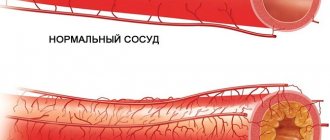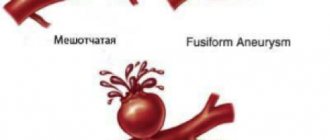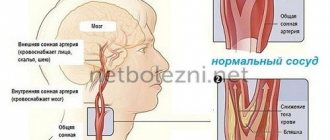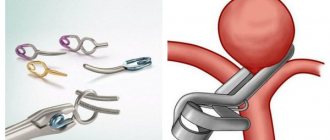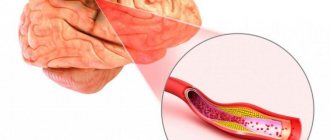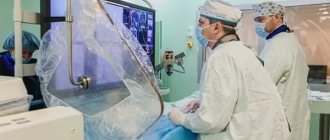Atherosclerosis is a change in the lining of blood vessels, in which plaques appear in the lumen of blood vessels. First, the disease affects the inner lining (intima) of the vessel, then the middle one. The lumen of the blood vessels narrows or becomes completely blocked. In this case, the blood supply to the organ fed by the vessel deteriorates. Organ functions are lost.
According to WHO, atherosclerosis in developed countries of the world ranks first among all diseases. 90% of deaths from cardiovascular diseases are complications of atherosclerosis.
The disease is more common in people over 50-60 years of age, but there is a tendency towards “rejuvenation”, and it all depends on the presence of risk factors. Men are affected more often than women, and the risk increases at a younger age. In women, the risk is higher after menopause.
Atherosclerosis is a chronic progressive disease. Patients need proper diagnosis and treatment. The specialists at the Yusupov Hospital have extensive experience in the treatment of cerebrovascular diseases. Without adequate measures, cerebral atherosclerosis develops into a stroke, so it is important not to waste time and promptly begin therapy.
ICD code - I67.2 Cerebral atherosclerosis.
Causes of development of vascular atherosclerosis
Atherosclerosis of cerebral vessels does not occur due to just one factor; it is usually caused by a complex of reasons. Among them:
- Elderly age. The risk of development increases over the years; this is a natural process of aging of the body.
- Floor. Men are more susceptible. The disease begins at a younger age than in women.
- Lipid imbalance. It is believed that there are “good” lipids - HDL, high-density lipoproteins, and there are “bad” lipids - LDL, low-density lipoproteins. HDL has positive properties: it prevents the formation of cholesterol plaques. LDL, on the contrary, “attracts” cholesterol to the blood vessels.
- Genetic predisposition. Lipid imbalance is sometimes caused by genes. This is the disease familial hypercholesterolemia.
- High cholesterol levels. Cholesterol is one of the main components of plaque on blood vessels.
- Smoking. It has been established that components of tobacco smoke cause vasospasm. In addition, nicotine promotes the attachment of cholesterol plaques to the intima of blood vessels.
- Obesity. In people with excessively developed subcutaneous fat, the balance of lipids in the body is disturbed. Obesity is also a risk factor for diabetes and hypertension. They themselves significantly increase the risk of atherosclerosis. Body weight is assessed using the Quetelet index - BMI = weight, kg / height * height, m2. The normal weight window is from 18.5 to 24.9 kg/m2.
- Physical inactivity. A sedentary lifestyle also affects the body's lipid metabolism. In addition, it is a factor in the development of obesity.
- High blood pressure. Hypertension leads to impaired vascular function. They become more susceptible to atherosclerosis.
- Diabetes. All types of metabolism in the body are disrupted. The concentration of LDL increases, therefore, the risk of atherosclerosis increases.
- Alcohol. Alcohol abuse leads to hypertension and changes in all organs.
- Stress. Negatively affects the tone of cerebral vessels.
Expert opinion
Author: Elena Mikhailovna Bunina
Psychiatrist, doctor of the highest category
Atherosclerosis is considered to be a blockage of the arteries and a decrease in their volume that occurs due to atherosclerotic plaques. It is considered one of the most dangerous ailments, since the disease progresses slowly, but at the same time it strongly constricts the blood vessels, disrupting proper blood circulation, leading to their complete blockage.
Sclerosis of cerebral vessels can be avoided or at least slowed down the progression of the disease if you consult a doctor in time. The most common causes of sclerosis are:
- high blood pressure;
- smoking and excessive consumption of alcoholic beverages;
- high blood cholesterol;
- constant stress;
- excess body weight;
- sedentary lifestyle;
- diabetes;
- unhealthy diet with excess fat in the diet.
If you keep these factors under control, you can reduce your risk of developing the disease. The peculiarity of the course of the disease is that even with an individual approach to treatment and effective therapy, blockage of blood vessels cannot be completely cured. Medicines and other methods of combating the disease can only slow down the growth of atherosclerotic plaques; with more intensive treatment, they can be reduced in size.
The doctor prescribes treatment for each patient individually, based on the initial condition and severity of the disease. Doctors at the Yusupov Clinic will conduct a comprehensive examination of the patient and prescribe treatment in accordance with the diagnosis and side effects of the disease.
Symptoms
The first signs of vascular damage to the brain may appear already at a young, working age. In this case, patients tend to ignore painful symptoms and not consult a doctor. And even when visiting a therapist or neurologist, the condition often remains unrecognized.
Among the early signs:
- absentmindedness;
- memory loss;
- fatigue;
- decreased performance;
- headache;
- noise in the head;
- episodes of dizziness;
- weather sensitivity.
Signs of circulatory problems may appear one by one. Young patients often associate them with overwork, as they believe that it is too early for them to be sick.
Over time, negative lifestyle factors lead to a deterioration of the condition - normal activities begin to suffer, severe weather sensitivity worries, and a person’s character “deteriorates.”
But sometimes the situation changes dramatically. In such cases, they speak of acute cerebrovascular accidents. How to recognize typical vascular diseases?
Encephalopathy
This diagnosis has already become “the talk of the town”: it is used to scare patients with hypertension, and it is “gifted” to old women who make scandals in pharmacies, clinics and on the street. And no wonder. The first symptoms of the disease are often noticeable behavioral, emotional and volitional disturbances. Thus, patients experience:
- irritability;
- emotional lability;
- sleep disorders;
- fatigue;
- depressive symptoms.
Relatives may notice that such a relative has become angry, sensitive to changes in weather, and his personality traits have become “sharpened.” Sentimental people become whiny, punctual people become pedantic, thrifty people become frankly stingy.
Over time, productivity begins to suffer: memory and attention deteriorate. The person becomes absent-minded, “constantly writes down so as not to forget,” but still forgets. Episodes of inappropriate, rude behavior are possible.
Discirculatory encephalopathy progresses, the course can be uniform or with sudden episodes of deterioration. It cannot be cured, you can only slow down the development of the disease. Severe encephalopathy is characterized by the development of dementia. Such a patient has completely lost self-care skills, in some cases cannot control physiological functions, and needs constant care and supervision.
Osteochondrosis often provokes or intensifies the manifestations of encephalopathy, as it impairs blood flow to the brain due to narrowing of the lumen of the vertebral arteries. Slow personality changes due to vascular damage also occur in systemic diseases accompanied by vasculitis.
Stroke
Stroke is one of the most common causes of death in people around the world. In fact, this is an acute circulatory disorder in the cerebral vessels, in which the entire brain lesion dies. According to the mechanism of development, there are 2 types of strokes: ischemic and hemorrhagic.
In ischemic stroke, the lumen of the vessel is blocked. Brain cells are very sensitive to hypoxia. At first, they try to provide for themselves through anaerobic glycolysis; within a few hours, the pathological processes are reversible. But decay products gradually accumulate, and the pH of the tissue changes to the acidic side. Neurons swell, their membranes cease to perform their functions and are destroyed. The final formation of the stroke focus occurs within 2-7 days; specialist assistance is most effective during the first 3-6 hours.
With a hemorrhagic stroke, the integrity of the vessel is compromised. Blood pours under the membranes, into the parenchyma (tissue) of the brain, and breaks into the ventricles. The cause of such a catastrophe is changes in the structure of the vascular wall and fluctuations in blood pressure. Congenital or acquired cerebral aneurysm can cause sudden death or severe disability. Until it reaches a large size, there is no pressure on the brain, and there are no clinical manifestations. The condition may worsen acutely, the patient is concerned about:
- headache;
- nausea;
- double vision;
- convulsions;
- disturbances of consciousness.
A special place is occupied by transient ischemic attacks, or as they say - micro-strokes. The name “microstroke” is unscientific; it reflects the reversibility of what occurs in the patient’s tissues. Some people who have had ischemic attacks are not aware of this. Thus, patients are greatly surprised to learn about them when describing a routine computed tomography or magnetic resonance imaging. (“I thought it was a simple hypertensive crisis!”)
Symptoms and prognosis for cerebrovascular accidents depend on the volume and location of the lesion. It is worth recalling obvious signs, the detection of which requires immediate medical attention:
- severe headaches, often with dizziness, tinnitus;
- asymmetry of the face, it is impossible to raise your hands, smile, show your teeth;
- weakness, numbness in the arms and legs, unsteadiness of gait;
- violation of pronunciation and perception of addressed speech;
- nausea and vomiting;
- disturbance, loss of consciousness.
Symptoms and signs of cerebral atherosclerosis
The disease develops in stages. Each individual stage has its own symptoms. However, in the “zero”, preclinical period of atherosclerosis there are no symptoms at all, there are only changes in blood vessels that are detected instrumentally.
Initial stage of cerebral atherosclerosis
This is the phase of general malaise. It is also called asthenic.
Complaints:
- Headache;
- Heaviness in the head, dizziness;
- Noise in ears;
- Weakness, inability to work for a long time;
- Fast fatiguability;
- Sleep problems;
- Mood swings;
- Decreased memory and concentration.
Cerebral atherosclerosis is rarely diagnosed at this stage. With such a clinical picture, patients, as a rule, do not go to the doctor, attributing their poor health to high blood pressure or fatigue.
The second stage of cerebral atherosclerosis
At the second stage, previous complaints are aggravated and supplemented by new neurological symptoms:
- Swallowing disorder. Occurs due to a disorder of the innervation of the palate, pharynx and tongue.
- Changes in speech and voice. The reason for this phenomenon is the same as for swallowing disorders. The voice becomes dull, and speech becomes incomprehensible and unclear.
- Involuntary laughter, crying. However, they are not related to the emotional state of the patient.
- Loss of coordination. Walking becomes difficult, and hand movements disappear. Fine motor skills deteriorate.
- Amyostatic syndrome: slower movements, increased muscle tone, loss of gestures and facial expressions.
- Reflexes of oral automaticity. When touching the lips or nose, a reflex stretching of the lips occurs. Usually not detected in everyday life.
- Impaired memory and intelligence. Vascular dementia develops (see consequences below).
The third stage of cerebral atherosclerosis
Symptoms:
- Deterioration of memory and intelligence. Old memories disappear, professional skills are lost. The patient becomes helpless and cannot care for himself. Gets lost in familiar places.
- Postural disorders. Gait and movement disorders are even more noticeable.
- Fainting. Temporary loss of consciousness in the classic version.
- TIA - transient ischemic attack. Manifested by dizziness with nausea and vomiting. Accompanied by bright flashes of light before the eyes. After the attack, the patient feels disoriented and temporarily loses memory. A TIA attack is very similar to a stroke. The main difference is that TIA is not accompanied by necrosis of a portion of the cerebral cortex. All symptoms completely disappear within 24 hours.
- Minor stroke. Similar to TIA, but neurological symptoms last from 2 to 21 days. After a minor stroke, just like with a TIA, there is no organic damage to the cerebral cortex.
Occlusion of blood vessels supplying blood to the brain
Occlusive processes in the arteries supplying the brain are fraught with dangerous consequences. Impairment of cerebral blood supply is fraught with the development of a stroke or ischemic cerebral infarction, and this often ends in the patient’s death, paralysis or dementia. A common cause of this is carotid artery occlusion. It is accompanied by loss of consciousness, nausea and vomiting, impaired coordination, speech and vision, weakness and numbness of the limbs. A harbinger of strokes are transient (cerebral) ischemic attacks, which we described in detail earlier.
Diagnosis of cerebral atherosclerosis
It is impossible to diagnose cerebral atherosclerosis based on complaints alone. The examination includes mandatory and additional studies.
Mandatory studies:
- Blood biochemistry: total cholesterol, LDL, HDL, triglycerides;
- General blood analysis;
- Blood sugar;
- Coagulogram;
- Atherogenic coefficient;
- ECG;
- Dopplerography of extracranial arteries.
Additional research:
- Blood biochemistry: liver transaminases (ALT, AST), creatinine, CPK;
- Coagulogram for D-dimer;
- Enzyme-linked immunosorbent assay (ELISA): determination of antinuclear factor;
- Protein fractions;
- C-reactive protein;
- Duplex scanning of head and neck vessels;
- Color Doppler mapping (ultrasound option);
- EchoCG;
- MRI, CT with contrast;
- PAT;
- SCT angiography of brachiocephalic arteries;
- Examination of the fundus to detect changes in the retinal vessels.
A set of necessary studies is available at the Yusupov Hospital.
Cases when consultations with specialized specialists are required:
- Suspicion of acute coronary syndrome - cardiologist.
- Stenosing lesions of neck vessels - angiosurgeon.
- Lesions of intracranial arteries - neurosurgeon.
- Problems with blood clotting - hematologist.
- High blood sugar - endocrinologist.
- Severe mental disorders - psychiatrist.
Treatment of cerebral atherosclerosis
Treatment of the disease depends on many factors: the stage of the process, laboratory parameters, concomitant pathologies.
The following methods are used:
- Taking medications;
- Diet therapy;
- Surgery;
- Lifestyle correction (about it in the prevention section).
Drug therapy
The goal of treatment is to eliminate the lipid imbalance and prevent the formation of an atherosclerotic plaque.
- Lipid-lowering drugs. The literal translation from Latin is drugs that reduce lipids in the blood.
- Statins. The most effective representatives of this group. Reduce the concentration of all types of blood lipids.
- Fibrates. They lower triglyceride levels better than statins, but do a worse job of lowering LDL.
- A nicotinic acid. Also reduces lipid concentrations, but less effectively than statins and fibrates.
- Bile acid sequestrants. Reduces the absorption of cholesterol from the gastrointestinal tract.
Under no circumstances should you start taking medications on your own. Everything should be according to an individually selected scheme. Statins are incompatible with some medications, and when taken with fibrates and nicotinic acid, they are fraught with rhabdomyolysis - the destruction of skeletal muscles.
Blood supply to the brain
Four large arteries are responsible for the transport of oxygen and nutrients to the brain tissues: two internal carotid and two vertebral. The vertebral arteries are responsible for supplying blood to the brain stem. At the base of the brain they merge into the basilar artery.
Each internal carotid artery is divided into anterior and posterior. These vessels supply the frontal, temporal, parietal, and occipital lobes.
At the base of the brain, the internal carotid branches, the basilar artery and the branches connecting them form a closed circle of Willis. It is named after the English doctor Thomas Willis. This anatomical formation ensures the redistribution of blood and the preservation of nutrition of parts of the brain during blockage of blood vessels. The outflow of blood from the cranial cavity occurs through the jugular veins.
Brain diseases occur when large and small vessels are damaged. Depending on the cause, symptoms occur acutely and require immediate medical attention or develop gradually, slowly leading to a deterioration in a person's quality of life.
The main causes of arterial damage include atherosclerosis and hypertension. In the first case, plaques form on the inner surface of the vascular wall, narrowing the lumen of the arteries. They have a thin cover and contain lipids inside. When such plaques rupture, blood platelets adhere to the damaged surface, leading to blockage of the lumen (thrombosis). The provoking factor is often vasospasm.
Arterial hypertension also damages the walls of blood vessels: they become denser, and areas of expansion (aneurysms) appear. These vulnerabilities can cause arteries to rupture or become blocked.
A condition in which small cerebral arteries are affected and the blood supply to the brain is affected is called discirculatory encephalopathy. Nerve cells do not receive enough oxygen and nutrients and die. A developed network of arteries cannot solve this problem. The process is not limited to any one area of the brain; lesions are found in various parts.
Diet for cerebral atherosclerosis
For atherosclerosis, table No. 10C according to Pevzner is prescribed. Basic principles:
- Reducing calories;
- Reducing the consumption of fats and easily digestible carbohydrates;
- Cooking food by boiling or steaming;
- Refusal of salt when preparing dishes;
- Small meals 5 times a day.
There are two diet options: for patients with normal weight and for overweight patients.
1st option. Patients with normal weight.
- Proteins - 90-100 g
- Fats - 80 g
- Carbohydrates - 350 g, of which up to 50 g sugar
- Calorie content - 2300-2500 kcal per day.
2nd option. Obese patients.
- Proteins - 80-90 g
- Fats - 70 g
- Carbohydrates - 250-300 g, sugar excluded
- Calorie content - 1800-2100 kcal per day.
Calorie standards are arbitrary. Adjustments are possible depending on gender, age and physical activity.
Some of the suitable products:
- From flour: rye bread, wheat bread with bran, grain bread.
- From cereals: oatmeal, rye, buckwheat, millet in the form of porridges. Limited - rice, semolina.
- Meat: chicken, turkey, boiled rabbit, lean beef.
- From fish: lean fish, boiled and baked.
- From dairy: kefir, yogurt, milk and cottage cheese with a low percentage of fat, plant analogues of milk.
- From eggs: steamed omelet.
- Vegetables: carrots, cabbage, zucchini, cucumbers.
- From fruits and berries: any, except very sweet ones.
- Drinks: green tea, chicory, carob, plant-based “milk” drinks.
The absence of a product on the list does not mean that it should not be consumed.
Prohibited products:
- Fatty meat and fish;
- Fried foods;
- Pickles and salty foods in principle;
- Smoked;
- Hot herbs and spices;
- Grape;
- Strong coffee;
- Chocolate, candies and other sweet products;
- Butter pastries;
- Honey, molasses, preserves and marmalade;
- Radish, radish, spinach;
- Juices containing sugar.
One of the menu options:
- First breakfast: oatmeal with water, low-fat cottage cheese, tea.
- Second breakfast: banana or apple.
- Lunch: lean cabbage soup with a piece of rye bread, steamed turkey cutlet.
- Afternoon snack: a glass of kefir.
- Dinner: chicken fillet, stewed cauliflower with green peas, fresh vegetable salad.
Specialists at the Yusupov Hospital create an individual menu for each patient, taking into account taste preferences. During their stay in the hospital, patients receive meals prepared by professional chefs with experience working in private hospitals in Europe.
Surgical intervention
Not all patients with atherosclerosis need surgery. Indications:
- Suffered a transient ischemic attack in the last 6 months;
- An ischemic stroke in the last 6 months;
- Stenosis of the internal carotid artery.
Carotid endarterectomy
Surgical intervention with high efficiency. Its essence is the removal of the inner layer of a vessel with an atherosclerotic plaque. The goal is to improve blood circulation and prevent stroke.
Before surgery, be sure to check the patient’s reaction to the cessation of blood flow through the internal carotid artery.
The operation is performed under local anesthesia or general anesthesia. The choice of pain relief depends on the patient's condition.
There are two options for the operation: classic and eversion, with the artery everting outward. For the patient there is no fundamental difference. Surgeons choose one or another tactic during the operation.
The main stages of classical endarterectomy:
- A skin incision is made from the ear and mastoid process to the middle of the neck;
- Subcutaneous fat, subcutaneous muscle, and fascia are cut layer by layer;
- The internal jugular vein is isolated, crossed and ligated;
- The common carotid artery is isolated;
- The common, internal and external carotid arteries are clamped;
- The internal carotid artery is cut;
- The plaque with the inner and middle walls is separated;
- Control the attachment of the inner layers of the vessel in undamaged areas;
- The arterial incision is closed;
- Remove the clamps from the vessels;
- Sutures are placed on the muscles and skin.
Extra-intracranial vascular microanastomosis (EICMA)
Indication: complete blockage of the internal carotid artery.
The essence of the operation is to create a communication between the intracranial artery and the external carotid artery.
As a result, blood bypasses the blockage of the internal carotid artery.
Carotid artery stenting
Indication: the patient has a high risk of complications after endarterectomy.
The essence of the operation is to install a stent into the artery, which expands its lumen.
The operation is minimally invasive and does not require anesthesia. A puncture is made in the femoral artery, a catheter with a stent is inserted into it, which reaches the internal carotid artery and “opens” like an umbrella. The lumen of the artery expands, and the blood supply to the brain is normalized.
Treatment of vascular blockages
There are many options for preventing and treating blood clots. Depending on the severity of the condition and the patient's medical history, the doctor prescribes various methods.
Disease prevention:
Quitting bad habits, urgent lifestyle changes:
- a diet low in saturated fat and cholesterol, less sugar and simple carbohydrates, and high in fruits and vegetables;
- body weight loss;
- ban on smoking and alcohol;
- fitness classes;
- minimizing stress;
- lowering blood pressure and cholesterol using folk remedies;
- maintaining low blood sugar levels by avoiding large amounts of sweets, jam, and sweets.
Drug treatment
Some medications help prevent clogged arteries, such as:
- cholesterol-lowering medications;
- drugs that lower blood pressure;
- blood thinners, which reduce the chance of dangerous blood clots.
Surgical intervention.
In the later stages of the disease, drug measures do not help improve the situation and then surgical procedures are used:
Stenting
A small tube called a stent is placed in the artery to maintain good blood flow. A catheter is inserted through an artery in the leg to reach the heart, and a stent is inserted through the catheter into the area of the blockage.
Coronary artery bypass grafting
In this surgery, arteries from other parts of the body are moved to the site of blocked arteries to help the blood reach its target destination.
Balloon angioplasty
A device is used that pushes the plaque towards the side walls of the arteries, resulting in the opening of the vessel lumen.
But in advanced cases, especially when the vessels of the legs are damaged, it is not possible to save the limbs, amputation is indicated.
Forecast and consequences
The prognosis for patients with cerebral atherosclerosis is ambiguous. The following factors play a role:
- Age;
- Stage of the disease;
- Timely start of treatment;
- Eliminating risk factors, following recommendations;
- Accompanying illnesses.
If the patient consults a doctor on time and immediately begins treatment, he has a chance to keep the disease under control. At the same time, the quality of life will not deteriorate.
However, without treatment and if recommendations are ignored, complications follow.
Ischemic stroke. Atherosclerotic plaques predispose to the formation of blood clots. The blood clot blocks the lumen, blood does not flow, and part of the cerebral cortex dies.
This type of stroke develops gradually, often after previous transient ischemic attacks. Often occurs during sleep. The patient wakes up with a headache, weakness, and numbness of the limbs. His speech is impaired. Neurological symptoms subsequently appear.
Symptoms:
- loss of sensitivity on one half of the face;
- paralysis of one half of the face;
- vision problems: patients see “floaters” in front of their eyes, flashes of light, double objects;
- unsteady gait;
- general weakness, numbness of the limbs.
If you have such signs, you should immediately consult a doctor. He will conduct a differential diagnosis. An ischemic stroke is similar to a cerebral hemorrhage. An error in diagnosis will cost the patient his life.
Treatment will be immediately prescribed to minimize the area of necrosis of the cerebral cortex. To determine the affected area, MRI and CT with contrast are performed.
After a stroke, patients need recovery and return to normal life. The Yusupov Hospital has a rehabilitation clinic with high-quality equipment, where stroke patients receive the necessary care. Rehabilitation methods:
- Kinesitherapy;
- Massotherapy;
- Biofeedback method;
- Electromyostimulation.
Vascular dementia. As a result of atherosclerosis, the blood vessels of the brain narrow. Less blood flows. Due to lack of blood supply to the brain, its functions are impaired. The first signs of vascular dementia: memory loss, disorientation, decreased concentration. The patient does not remember recent events and confuses names. At the same time, he realizes that he has become forgetful.
At this stage, it is important to start treatment as soon as possible, as the symptoms will continue to increase and changes in the mental sphere will become irreversible.
Causes
Vascular occlusions are associated with a state of vascular insufficiency. The occlusion process occurs:
- as a result of injuries, if the artery is compressed.
- due to the fact that the lumen is blocked by a thrombus or embolus.
The formation of blood clots is promoted by a chronic disease - vascular atherosclerosis. As atheromatous plaques grow and increase in diameter, they interfere with normal blood flow. Atherosclerotic plaque leads to blood clotting and blood clot formation. Occlusion is caused by separated plaque fragments that move freely along the vascular bed. In addition, as a result of atherosclerosis, the walls of blood vessels lose their elasticity, become thinner and stratify under blood pressure, which causes the formation of aneurysms. Thrombosis or embolism is likely to occur in the area of the vessel where the dilatation has appeared.
Prevention of cerebral atherosclerosis
- Eliminate risk factors. Some of them - unmodifiable ones - cannot be removed. However, quitting smoking and drinking, doing simple exercises and watching your diet are quite accessible means of prevention.
- Exercise stress. Useful for weight control and improving the functioning of the cardiovascular system. Important: before you start playing sports, you need to undergo an examination. Doctors will conduct stress tests and select an acceptable activity regimen. Otherwise, you can harm yourself and make your health worse. In everyday life, it is recommended to walk more, climb stairs instead of riding the elevator, and work in the garden. You need to walk for 30 minutes at least 3-4 times a week.
- Regular examinations with a doctor. At the Yusupov Hospital you can undergo a preventive examination. During the consultation, a specialist will help identify risk factors and eliminate them.
- Weight control. BMI should be between 18.5-24.9 (see above). At each visit to the doctor, you are weighed and your waist circumference is measured.
- Blood pressure control. The close connection of atherosclerosis with high blood pressure forces patients to monitor their blood pressure.
- Control of laboratory parameters: LDL, HDL, total cholesterol, triglycerides, transaminases, blood sugar.
